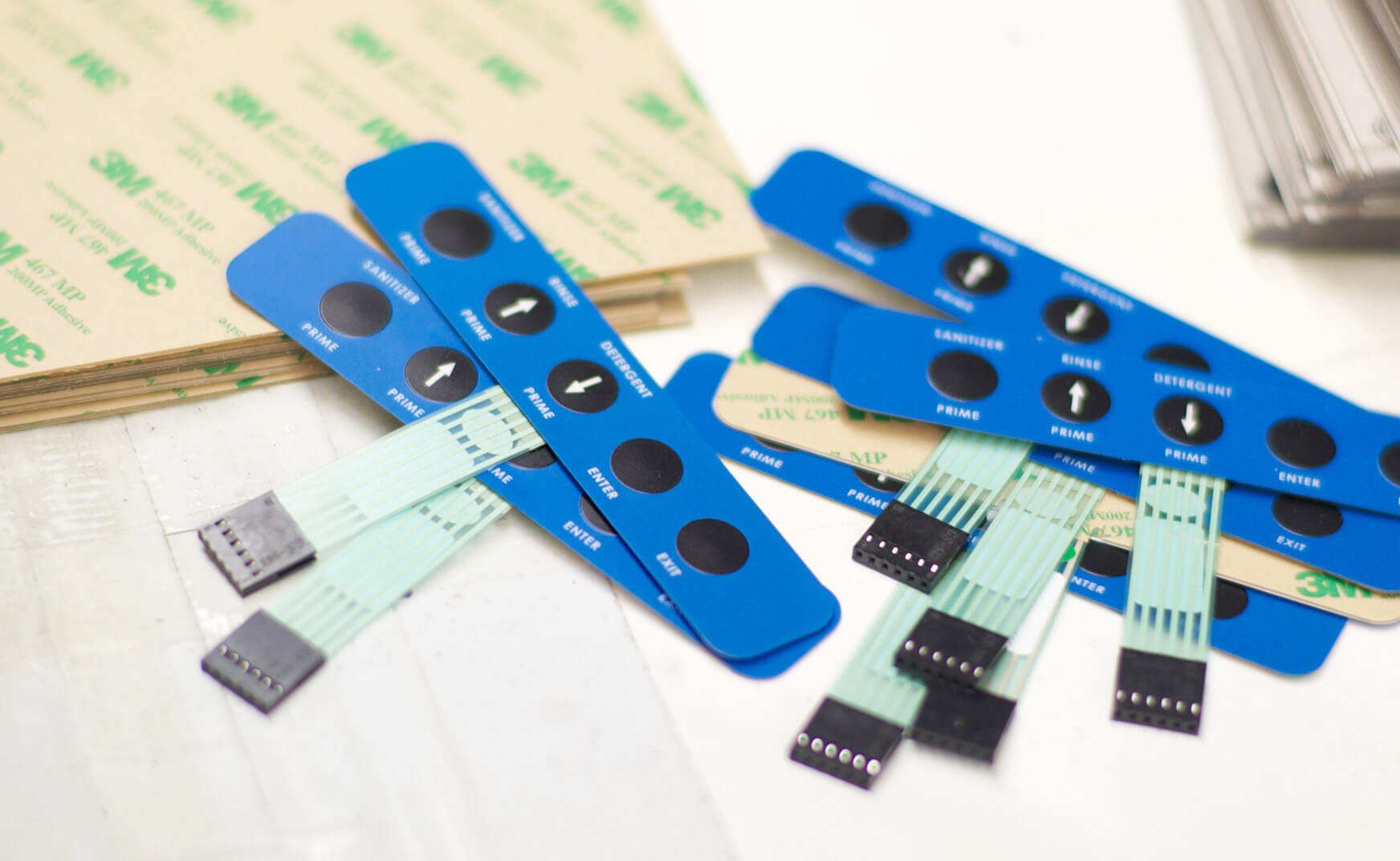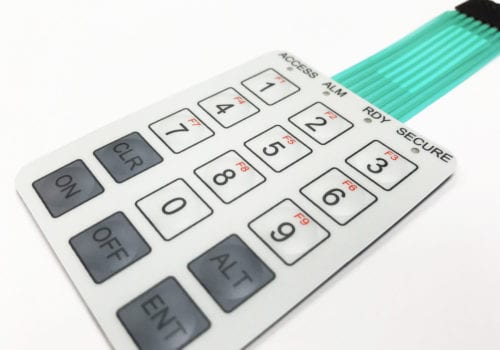A good membrane switch manufacturer offers flexible design options for complex applications.
A good membrane switch manufacturer offers flexible design options for complex applications.
Blog Article
Everything About Membrane Layer Switch Over: Comprehending Its Design and Functionality
When you assume concerning the control interfaces in contemporary tools, membrane switches frequently come to mind. Let's explore what collections membrane changes apart from various other control systems.
What Are Membrane Buttons?

Membrane layer switches can likewise be customized pertaining to shape, dimension, and graphics, enabling makers to develop unique interfaces tailored to certain products. On the whole, membrane buttons play a substantial function in improving customer experience across a large variety of applications.
Exactly How Membrane Layer Switches Over Job
When you push a key on a membrane layer button, it triggers an uncomplicated yet reliable mechanism. The leading layer, usually made from adaptable product, presses down onto a conductive layer beneath it. This activity bridges the space in between conductive traces, finishing an electrical circuit. As quickly as the circuit closes, it sends a signal to the tool's controller, which interprets your input.
You'll discover that the tactile comments varies based upon the switch style, supplying either a soft click or an extra obvious reaction. Once you launch the key, the membrane go back to its original position, resuming the circuit and stopping the signal. This procedure takes place practically instantly, making sure a receptive user experience.
Membrane switches are popular as a result of their durability and resistance to dirt and moisture, making them ideal for different applications, from household devices to medical devices. Recognizing this procedure aids you value their extensive use.
Key Elements of Membrane Layer Switches
Recognizing the key parts of membrane buttons is essential for comprehending their performance and layout. The protective layer guards against ecological elements and put on, expanding the button's lifespan. By comprehending these components, you'll acquire understanding into just how membrane changes operate and their value in different applications.
Materials Made Use Of in Membrane Switch Over Design
The efficiency and sturdiness of membrane switches over heavily depend upon the products utilized in their layout. You generally run into polyester and polycarbonate as main substrates due to their outstanding toughness and flexibility. These products resist scratches and chemicals, making them perfect for requiring atmospheres.
The conductive layers frequently use silver or carbon, picked for their reliability and conductivity. membrane switch manufacturer. Silver offers remarkable performance, while carbon is an affordable option. For the overlay, you might take into consideration a matte or shiny surface, depending on your visual needs and individual experience
Adhesives play an essential function too; they bond layers firmly and ensure durability. Ensure to pick adhesives that withstand environmental variables like temperature level and moisture. Do not neglect the significance of a good printing method for graphics, as it improves both performance and aesthetic charm. Selecting the ideal materials will ensure your membrane switch stands the test of time.
Design Considerations for Membrane Layer Buttons
While creating membrane buttons, it's important to take right into account various factors that affect their capability and individual experience. Beginning by concentrating on the design and button dimension; make specific they're intuitive and very easy to browse.
Don't overlook the graphic layout; clear labeling and shade comparison are substantial for visibility. Validate your layout suits environmental variables, like wetness or temperature variations, which could impact performance. Finally, keep in mind the relevance of testing prototypes with real users to collect feedback and make required modifications. This repetitive procedure aids you improve the layout, validating it fulfills both functional and visual requirements successfully. By carefully taking into consideration these elements, you'll develop a membrane layer switch that improves usability and fulfillment.
Applications of Membrane Switches
Membrane buttons are flexible elements discovered in different applications, from this content commercial devices to consumer electronic devices. You'll see their effect in makers that need durable user interfaces and in gadgets that benefit from streamlined styles. Comprehending these applications helps you value the capability and practicality of membrane layer switches in day-to-day innovation.
Industrial Equipment Use
When you're looking to improve the functionality of industrial devices, membrane buttons provide a trustworthy service that combines resilience with straightforward style. These switches are perfect for harsh settings, providing resistance to dust, dampness, and chemicals. You'll locate them in control panels for manufacturing makers, a/c systems, and clinical devices, where accuracy and responsiveness are crucial. Their reduced profile find here indicates they fit perfectly right into numerous tools, conserving important room while keeping ease of use. With personalized graphics and backlighting options, you can create an intuitive interface for drivers, boosting effectiveness and safety. Plus, their lengthy lifespan decreases upkeep prices, making them a clever investment for your industrial applications. Accept membrane layer buttons to simplify your operations and enhance overall efficiency.
Consumer Electronic Devices Combination
In the domain name of consumer electronics, membrane layer switches play an essential duty in boosting customer interaction and device performance. Membrane layer buttons also ensure durability and resistance to dust and wetness, extending the lifespan of your electronic devices. By selecting membrane layer buttons, you enhance not simply the performance yet also the design of your devices, making everyday communications smooth and delightful.
Advantages and Drawbacks of Membrane Layer Buttons
While membrane switches offer an array of benefits, they likewise feature some downsides that you should take into consideration. One significant advantage is their portable style, making them ideal for space-constrained applications. They're likewise cost-efficient, giving a durable remedy with a reduced manufacturing expense. In addition, their smooth surface area is very easy to tidy, improving hygiene in environments like medical facilities.

Membrane switches can have a shorter life expectancy contrasted to mechanical buttons, particularly under heavy usage. They can also be less tactile, which may influence individual comments these details throughout operation. Balancing these pros and disadvantages will assist you determine if membrane buttons are the best fit for your task.
Often Asked Inquiries
How Much Time Do Membrane Switches Normally Last?
Membrane changes normally last between 5 to 10 years, depending upon use and environmental conditions. You'll intend to examine elements like wear, exposure to moisture, and temperature fluctuations to determine their long life efficiently.
Can Membrane Switches Be Personalized for Certain Styles?
Yes, you can personalize membrane layer buttons to fit particular designs (membrane switch manufacturer). You'll have the freedom to select shades, shapes, and formats that match your task's needs, guaranteeing they blend seamlessly with your overall aesthetic
What Is the Expense Range for Membrane Switch Manufacturing?
The cost range for membrane layer button production generally falls in between $1 and $10 each, depending upon elements like style intricacy, amount, and materials. You can obtain quotes from suppliers to find the most effective option.

Are Membrane Switches Over Waterproof or Immune?
Membrane layer switches can be designed to be water resistant or resistant, depending upon materials utilized and construction approaches. If you require them for damp settings, guarantee you specify those needs throughout the style procedure.
Just How Do Membrane Layer Switches Contrast to Conventional Buttons?
Membrane layer buttons are generally thinner and more flexible than traditional buttons, offering a streamlined style. They're often much easier to cleanse and incorporate, however may not provide the responsive feedback you're used to with mechanical options.
Conclusion

Report this page